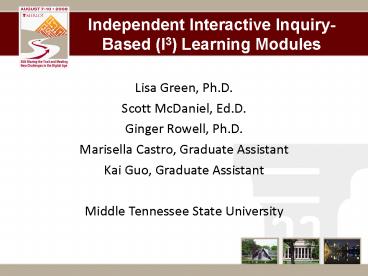Independent Interactive InquiryBased I3 Learning Modules - PowerPoint PPT Presentation
1 / 15
Title:
Independent Interactive InquiryBased I3 Learning Modules
Description:
By using audio-visual technology, interactive ... Answers from the wrap-up portion of the module were compared to answers from the ... Wrap-up Question: ... – PowerPoint PPT presentation
Number of Views:33
Avg rating:3.0/5.0
Title: Independent Interactive InquiryBased I3 Learning Modules
1
Independent Interactive Inquiry-Based (I3)
Learning Modules
- Lisa Green, Ph.D.
- Scott McDaniel, Ed.D.
- Ginger Rowell, Ph.D.
- Marisella Castro, Graduate Assistant
- Kai Guo, Graduate Assistant
- Middle Tennessee State University
2
Outline
- Hypothesis
- Project Goals
- Implementation
- Results
- Further Work
3
Hypothesis
- By using audio-visual technology, interactive
learning modules for teaching statistics can be
developed that will provide opportunities for
students to complete inquiry-based learning
independent of a teacher.
4
Project Goals
- Develop discovery-based interactive audio-visual
instructional modules to improve student learning
of post-calculus probability and statistics
concepts. - Evaluate the effectiveness of this learning
approach and these learning objects.
5
Implementation
6
Statistical Significance
http//mcdaniel.mtsu.edu/I_cubed/I_cubed/
Learning Goals Use simulation to help develop
the understanding of the concept of statistical
significance.
7
Evaluation of Module
- The Statistical Significance module was assigned
to 110 students in both Calculus-based and
non-Calculus based classes. - Students took a pre-test, then did the module.
Answers from the wrap-up portion of the module
were compared to answers from the pre-test.
8
Questions
- Pretest Question
- Define p-value in the context of a difference
between groups. - Wrap-up Question
- If the p-value is around 5 or less, would you
say that the difference in the two groups is
likely to have occurred by some treatment other
than chance? Explain.
9
Rubric
- 4 points Exemplary Response, All of the
following characteristics must be present. - The answer is correct.
- The explanation is clear and complete.
- 3 points Good Response, Exactly one of the
following characteristics is present. - The answer is correct but there is a minor flaw
in wording - The explanation lacks clarity
- The explanation is incomplete
10
Rubric (Continued)
- 2 points Inadequate Response, Exactly two of the
characteristics in the 3-point section are
present OR One or more of the following
characteristics are present. - The answer is incorrect due to a major flaw the
wording but implies some understanding of the
concept. - Explanation lacks clarity or is incomplete but
does indicate some correct and relevant
reasoning. - There is a partial explanation but the thought is
not carried out - 1 point Poor Response, two of the following
characteristics must be present. - The answer is incorrect.
- The explanation, if any, uses irrelevant
arguments. - The explanation just restates the problem in
other words - 0 points No Response
- The students paper is blank or contains only
wording that appears to have no relevance to the
problem.
11
Rubric (Continued)
- Examples for Statistical Significance
- 4 The p-value is the probability of obtaining a
result at least as extreme as the given data
point. The p-value of an observed value is the
probability that, given that the null hypothesis
is true, it will have a value as or more
unfavorable to the null hypothesis. - 3 The p value provides evidence that the
results do not occur by random sampling
variations alone. - 2 P-values can indicate if there is a
significant difference in values or treatments. - 1 The probability that an event will occur.
- 0 I don't know what it means.
12
Graders
- There were 3 independent graders
- A Graduate Assistant reviewed and graded each
response first. - Each response was then graded separately by Dr.
Green and Dr. McDaniel. - Lastly, Dr. Green and Dr. McDaniel met to discuss
any grading issues that may have come up during
the initial grading.
13
Results
14
Future Work
- Construct questions so that they can be graded
more easily. - Change the wording of some questions students may
have found to be confusing. - Prepare Learning Modules for release.
- Create addition modules.
15
I3 Learning Modules
- This project has been made possible from funding
by the National Science Foundation (NSF) Division
of Undergraduate Education Materials Development
Proof-of-Concept grant. - NSF 0443088































